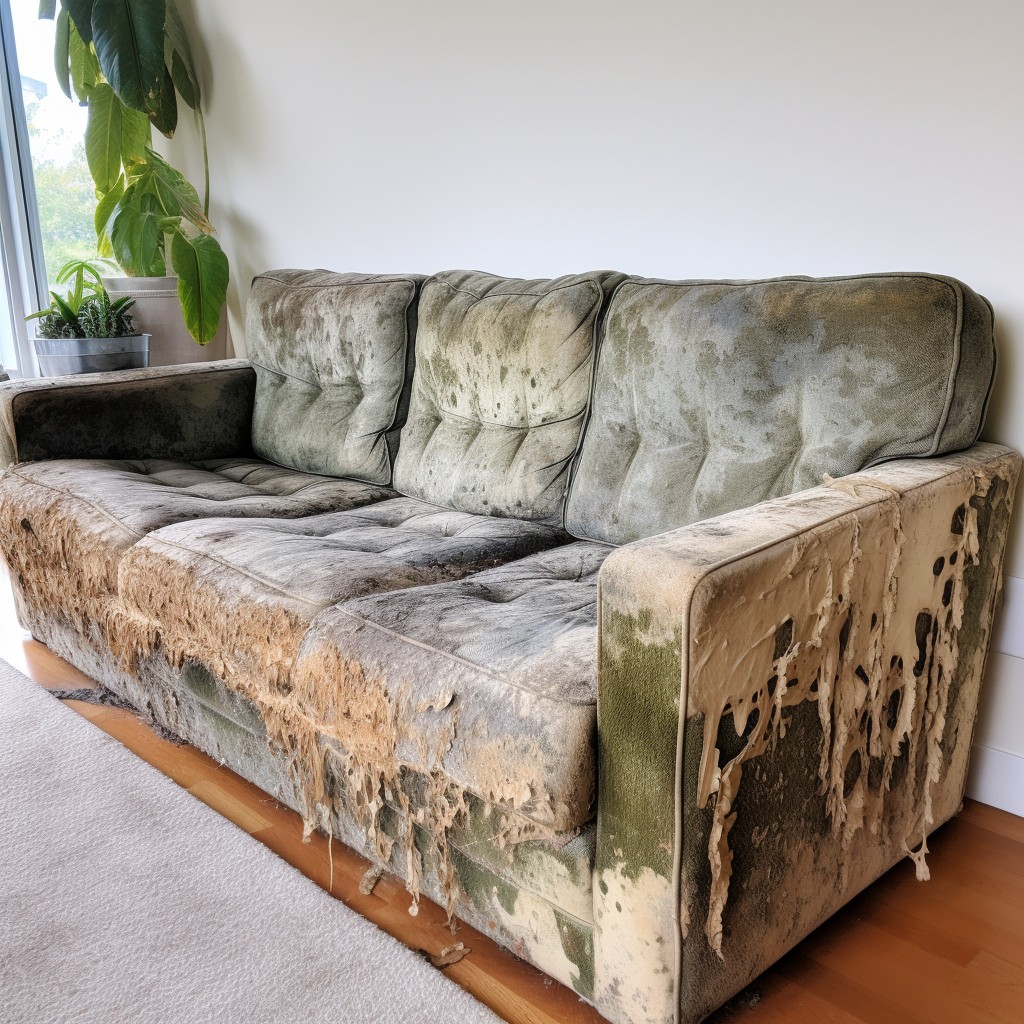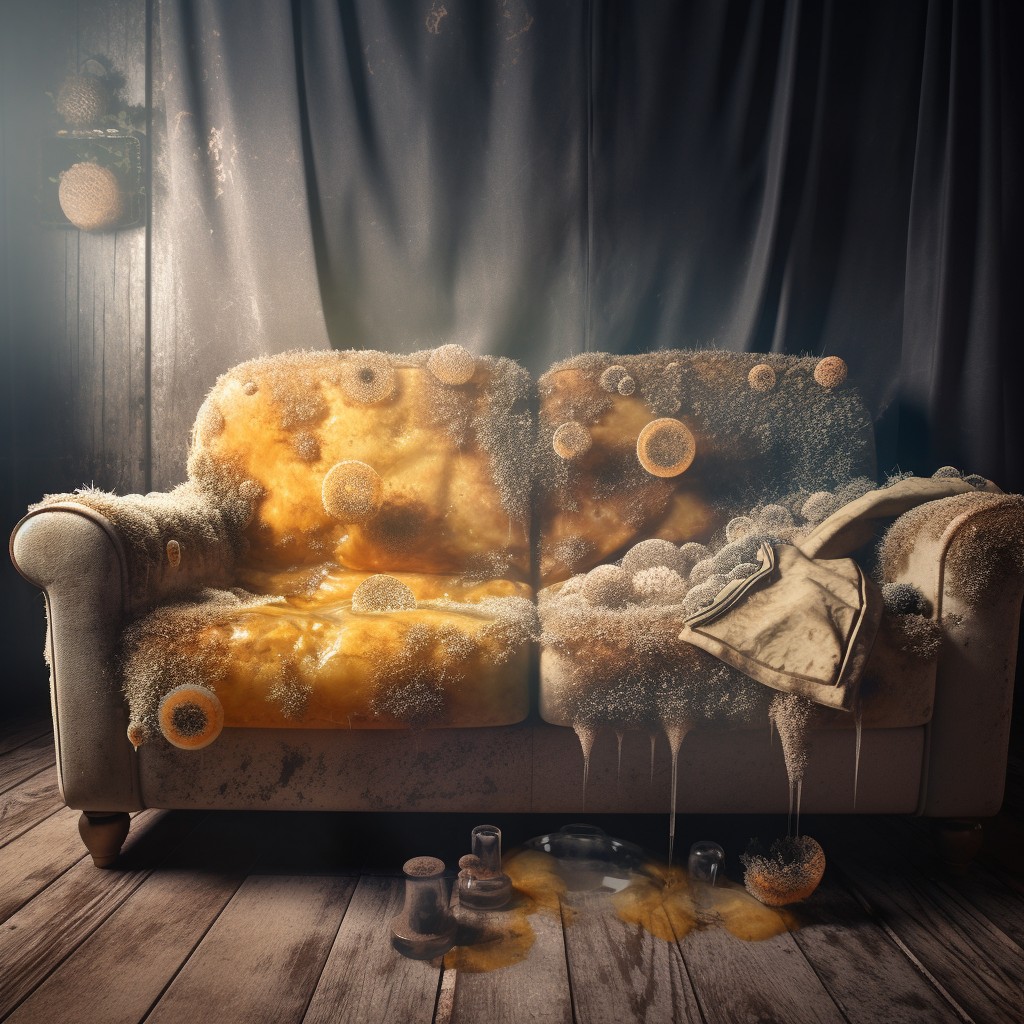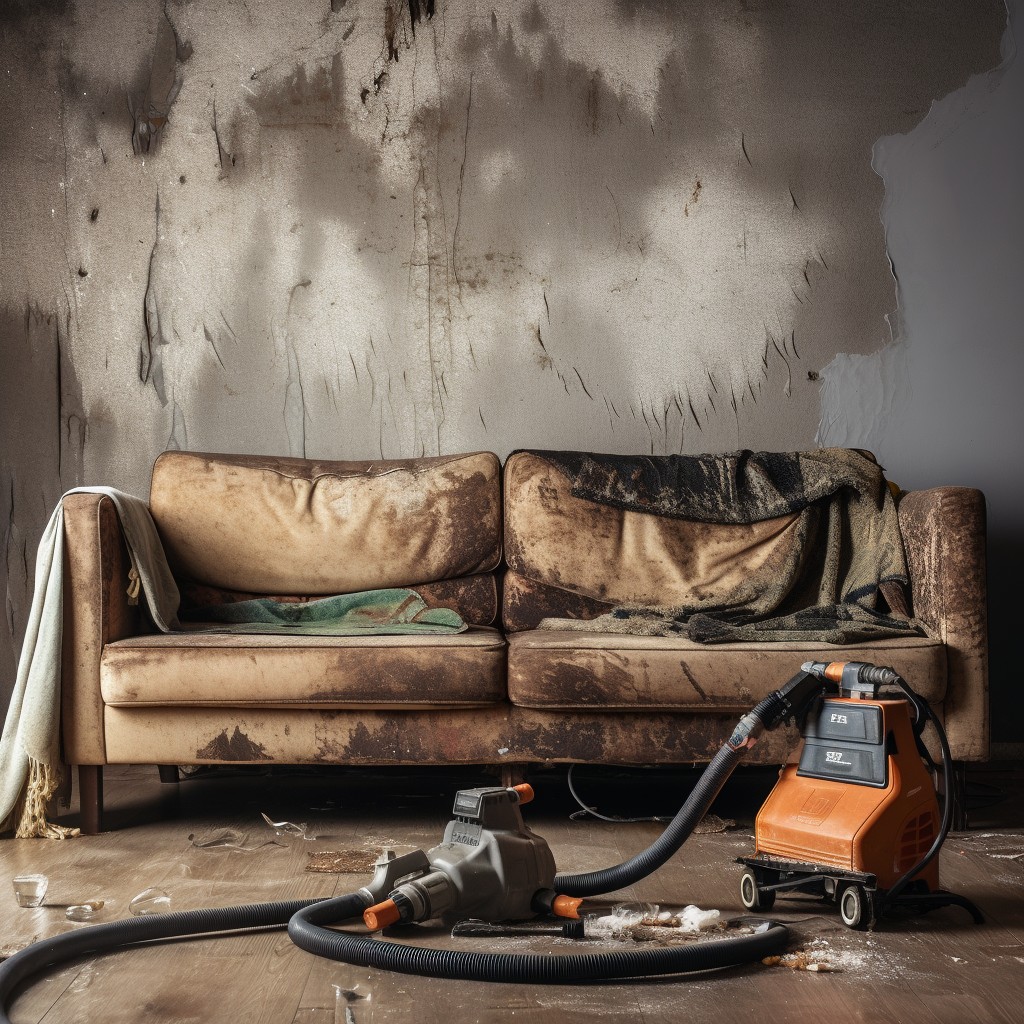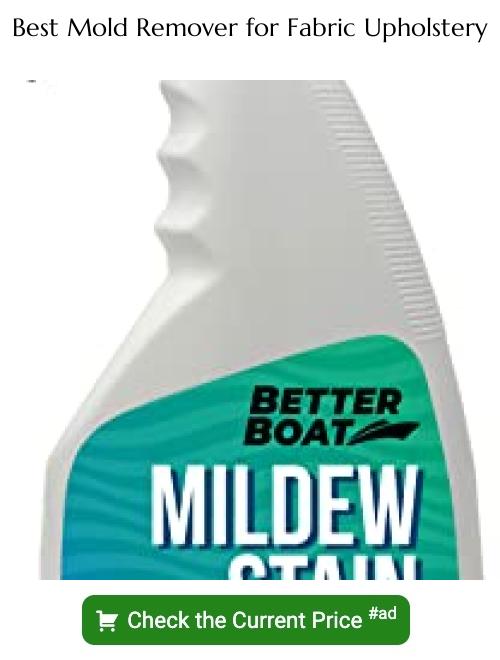Last updated on
Discover the effective steps to eliminate mold from your couch, ensuring a clean and healthy living space for you and your loved ones.
Mold is one of the most unpleasant things you can find in your home. It’s not only unsightly, but it can also be dangerous to your health.
And if you’ve found mold on your couch, that’s a big problem. Not only is it difficult to remove, but it can also spread quickly and easily throughout the rest of your home.
But fear not! In this article, we’ll show you how to get mold out of couches and keep them clean and safe for years to come. So grab a cup of coffee and let’s dive in!
Table of Contents
Identifying Mold On Couch

The first step in removing mold from your couch is identifying it. Mold can come in many different colors and textures, but the most common types found on furniture are black, green or white.
It often appears as a fuzzy growth that spreads quickly if left untreated.
To identify mold on your couch, start by looking for any discoloration or spots that appear to be growing. You may also notice a musty odor coming from the affected area.
If you’re still unsure whether what you’re seeing is actually mold, try using a piece of tape to lift some of the material off the surface of your couch. If it’s difficult to remove and has a slimy texture when touched with gloves on (never touch without gloves), then it’s likely mold.
Assessing the Extent of Damage

This will help you determine whether it’s possible to remove the mold yourself or if you need professional help.
Start by examining how much of your couch has been affected by mold. Is it just a small spot or has it spread throughout? If there are only a few spots, then removing them may be relatively easy and straightforward.
However, if there are large areas covered in mold, then this could indicate that there is more extensive damage that needs addressing.
Another factor to consider when assessing the extent of damage is how long the mold has been present on your couch. The longer it’s been growing unchecked; chances are high that its spores have already spread deep into cushions and other parts of furniture fabric.
Understanding Mold Health Risks and Symptoms

Exposure to mold can cause a range of symptoms, from mild irritation to serious respiratory problems. Some people are more sensitive than others and may experience more severe reactions.
Symptoms of mold exposure include coughing, wheezing, sneezing, runny nose or nasal congestion, itchy eyes or skin rash. In some cases where the exposure is prolonged and severe enough there could be fever and shortness of breath.
It’s important to note that different types of molds have varying levels of toxicity; therefore understanding the type you’re dealing with will help in determining how best you should handle its removal.
Preparing for Mold Removal

Mold spores can easily spread through the air, so taking precautions is essential for your safety.
Firstly, make sure that you wear protective gear such as gloves and a mask to avoid inhaling any harmful particles. You should also cover nearby furniture with plastic sheets or move them out of the room altogether.
Next, open all windows in the room to allow proper ventilation during cleaning. This will help reduce moisture levels in the air which can contribute to mold growth.
It’s also crucial that you identify what caused mold growth on your couch before starting removal procedures. If there is an underlying issue like water damage or high humidity levels in your home, then simply removing visible mold won’t solve anything – it will just keep coming back!
Check Manufacturer’s Cleaning Instructions
Different types of fabrics and materials require different methods of cleaning, and using the wrong method can cause more harm than good. The manufacturer’s instructions will provide guidance on what type of cleaners or solutions are safe to use on your couch without damaging it.
If you cannot find the manufacturer’s instruction tag attached to your furniture piece, try searching for them online or contacting customer service for assistance. If there is no information available from either source, proceed with caution when choosing a mold removal solution.
Ignoring these guidelines may lead to discoloration or damage that could have been avoided by following proper procedures.
Choosing the Right Cleaning Equipment
The type of equipment you use will depend on the severity and location of mold growth.
For surface-level mold, a simple vacuum cleaner with an upholstery attachment can do wonders. Make sure to use a HEPA filter in your vacuum as this will trap any airborne spores that may be released during cleaning.
If there is visible mold growth beneath or within cushions, consider using a steam cleaner. Steam cleaners are effective at killing and removing stubborn molds from deep within fabrics without damaging them.
For more severe cases where bleach or vinegar solutions are required for removal, make sure to wear protective gloves and goggles while applying these chemicals. Ensure proper ventilation by opening windows or turning on fans before starting the cleaning process.
Vacuuming the Couch
The first step is vacuuming. Vacuuming helps remove loose mold spores from the surface of your couch before you begin cleaning.
To vacuum your couch, use a brush attachment or upholstery tool to gently sweep over all surfaces of the furniture piece. Be sure to get into all crevices and seams where mold may be hiding.
It’s important not to press too hard while vacuuming as this can push spores deeper into cushions or fabric fibers making them harder to remove later on in the process.
Once you’ve finished vacuuming, dispose of any debris collected in a sealed bag outside immediately. This will prevent any remaining spores from spreading throughout other areas in your home during disposal.
How to Use Vinegar to Remove Mold
It’s also affordable and readily available in most households. To use vinegar for mold removal, mix equal parts of white vinegar and water in a spray bottle.
Spray the solution onto the affected areas of your couch, making sure to saturate them thoroughly. Let it sit for about an hour before wiping away with a clean cloth or sponge.
If you’re dealing with stubborn mold stains that won’t come off easily, try adding baking soda to the mixture before spraying it on your couch. This will create a paste-like substance that can be applied directly onto the affected area.
After applying either solution (vinegar or baking soda), rinse off any residue with warm water and dry thoroughly using towels or fans if necessary.
Remember not to oversaturate your couch as this may cause damage over time. Also, avoid using undiluted vinegar as it may discolor some fabrics permanently.
How to Apply a Bleach Solution Safely
It’s important to use bleach safely and correctly to avoid damaging your furniture or harming yourself in the process.
To apply a bleach solution safely, start by mixing one cup of household bleach with one gallon of water. Then, put on gloves and protective eyewear before applying the solution directly onto the affected areas using a spray bottle or sponge.
Be sure not to oversaturate the couch with too much liquid as this can cause further damage. After applying the solution evenly across all moldy spots on your couch let it sit for 15 minutes before rinsing thoroughly with clean water.
It’s essential always read manufacturer instructions carefully when working with cleaning products containing chemicals like chlorine-based bleaches since they may have specific dilution ratios or application methods that differ from general guidelines.
Utilize Baking Soda and Water Solution
Baking soda has powerful cleaning properties that can help eliminate mold spores and prevent them from returning.
To create a baking soda solution, mix one-quarter tablespoon of baking soda with one cup of water in a spray bottle. Shake the mixture well until the baking soda dissolves completely.
Spray the solution onto the affected areas of your couch and let it sit for 10-15 minutes. Then use a soft-bristled brush or sponge to scrub away any remaining mold stains gently.
Afterward, rinse off any residue with clean water using another cloth or sponge before drying thoroughly with towels or fans if necessary.
Baking Soda is safe on most fabrics but always test on an inconspicuous area first before applying it all over your furniture piece.
Consider Commercial Mold Removal Products
These products are specifically designed to eliminate stubborn and persistent molds that can’t be removed by regular cleaning methods.
When choosing a commercial product, make sure it’s safe for use on upholstery and won’t damage the fabric of your couch. Always follow the manufacturer’s instructions carefully and wear protective gear such as gloves and masks when applying the solution.
It’s important to note that some commercial mold removal products contain harsh chemicals that can pose health risks if not used properly. If you have children or pets in your home, consider using natural alternatives such as vinegar or baking soda instead.
Remember, prevention is always better than cure when it comes to mold growth in your home. Regularly inspecting your furniture for signs of moisture buildup or dampness can help prevent future outbreaks from occurring.
Applying Mold Removal Solution
Before applying any cleaning solution, make sure that you test a small and inconspicuous area of the couch first. This will help ensure that there are no adverse reactions or discoloration.
When applying the mold removal solution, use a soft-bristled brush or sponge and gently scrub the affected areas in circular motions. Be careful not to damage any delicate fabrics on your couch while doing so.
It is important to note that different types of solutions work better for different types of molds and materials used in making furniture. For instance, vinegar works well for removing mildew from leather but may cause discoloration if applied on suede material.
After scrubbing thoroughly with the cleaning agent, let it sit for about 10-15 minutes before rinsing off with clean water using a damp cloth or sponge until all traces of soap residue are gone.
Brushing the Mold Away
Use a soft-bristled brush or sponge and gently scrub the affected areas in circular motions. Be sure not to press too hard as this can damage your couch’s fabric.
As you brush, keep an eye out for any remaining spots of mold that may be hiding beneath the surface. If you find any, apply more cleaning solution and continue brushing until all traces of mold are gone.
It is important to note that if there is extensive damage or if there are large patches of visible growth on your couch, it may be best to call in a professional for help with removing them safely and effectively.
After brushing away all visible signs of mold from your couch, rinse thoroughly with clean water using a damp cloth or sponge. Make sure no cleaning residue remains on the surface before drying completely using fans or opening windows for ventilation purposes.
Rinse and Dry the Couch Thoroughly
This step is crucial in ensuring that all traces of mold are removed from your furniture.
To rinse off any remaining cleaning solution, use a clean cloth or sponge dampened with water. Make sure to wring out excess water before wiping down the couch.
Repeat this process until all of the cleaning solution has been removed.
After rinsing, allow your couch to air dry completely before using it again. You can speed up this process by opening windows or turning on fans in the room where your furniture is located.
It’s important not to skip this step as leaving moisture behind can lead to future mold growth on your couch. So take extra care when drying out every nook and cranny of your sofa!
Steam Cleaning for Extra Precaution
It’s a great option if you want to take extra precautions and ensure that all the mold spores are eliminated. Steam cleaning works by using high-temperature steam to kill the mold, making it easier for you to clean up any remaining residue.
To steam clean your couch, start by vacuuming it thoroughly with a HEPA filter vacuum cleaner. This will help remove any loose dirt or debris on the surface of your couch before steaming.
Next, fill up your steam cleaner with water and turn it on according to its instructions. Once heated up, hold the nozzle about 6 inches away from the affected area and move slowly across each section of fabric until all areas have been covered.
After steaming, use a dry cloth or towel to blot away excess moisture from your couch’s surface gently. Then let air-dry completely before using again.
Call a Professional Mold Remediation Service
A professional mold remediation service has specialized equipment and expertise that can help eliminate even the most stubborn mold growth. They will assess the extent of damage, identify any underlying issues causing moisture buildup, and provide a comprehensive solution for removing all traces of mold from your couch.
While hiring a professional may cost more than doing it yourself, it’s worth considering if you have severe or widespread contamination. Mold spores are microscopic and can easily spread throughout your home via air ducts or HVAC systems if not properly contained during removal.
In addition to eliminating existing mold growth on your couches, a professional service will also take steps to prevent future outbreaks by identifying potential sources of moisture in your home such as leaks or poor ventilation.
Remember that prevention is always better than cure when dealing with household molds.
Preventing Future Mold Growth
Here are some tips on how to do that:
1. Keep the area dry: Mold thrives in damp environments, so make sure your couch is kept in a dry area of your home.
2. Use a dehumidifier: If you live in an area with high humidity levels, consider using a dehumidifier to keep the air around your couch dry.
3. Clean regularly: Regularly cleaning and vacuuming your couch can help prevent mold growth by removing any dirt or debris that could provide a breeding ground for spores.
4. Avoid spills and stains: Try not to spill liquids or food on the couch as this can create moist conditions ideal for mold growth.
5. Allow proper ventilation: Make sure there is enough airflow around and under the furniture piece where possible; this will help reduce moisture buildup.
Regular Couch Maintenance Tips
Regular maintenance is key in keeping your couch clean and healthy for years to come. Here are some tips:
1. Vacuum regularly: Dust and dirt can accumulate on your couch over time, providing a breeding ground for mold spores.
2. Keep the area dry: Moisture is one of the main causes of mold growth, so make sure you keep the area around your couch as dry as possible.
3. Use a dehumidifier: If you live in an area with high humidity levels, consider using a dehumidifier to reduce moisture in the air.
4. Avoid eating on or near your couch: Food crumbs and spills can attract pests like ants or cockroaches which can contribute to moisture buildup leading up-to-mold formation.
5. Clean spills immediately- In case there’s any spillage while eating or drinking anything near/on sofa then clean it immediately before it gets absorbed into fabric fibers causing dampness/moisture build-up leading up-to-mold formation.
By following these simple tips along with regular cleaning practices such as wiping down surfaces with disinfectant wipes every few weeks will help ensure that no unwanted guests (molds) find their way back onto our beloved furniture pieces!
FAQ
What kills mold on couch?
Vinegar and bleach solutions can effectively kill mold on a couch, with vinegar killing 80% of mildew, mold, and toxic bacteria, and bleach being suitable for white fabrics and non-porous furniture.
Can moldy furniture be saved?
Moldy furniture can sometimes be saved depending on the time and amount of mold exposure, and if cleaning efforts are unsuccessful, it must be disposed of.
What can I spray on furniture to kill mold spores?
You can spray a solution of equal parts vinegar and warm water on furniture to kill mold spores.
What kills mold on fabric?
White distilled vinegar effectively kills mold on fabric when worked directly into the stain, pre-soaked in water mixed with one cup of vinegar, or added to the washing machine at 1-2 cups per cycle.
How can you prevent mold growth on couches in humid environments?
To prevent mold growth on couches in humid environments, maintain low humidity levels, ensure proper ventilation, and use mold-resistant couch materials.
Are certain upholstery materials more resistant to mold than others?
Yes, certain upholstery materials, like synthetic fabrics, are more resistant to mold than others, such as natural materials.
What health risks are associated with moldy furniture, and how can they be mitigated?
Moldy furniture can cause health risks such as allergies, respiratory issues, and skin irritation; mitigation includes proper cleaning, use of HEPA filters and air purifiers, and maintaining low humidity levels.





